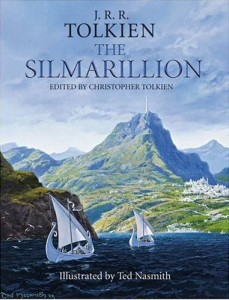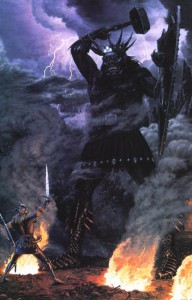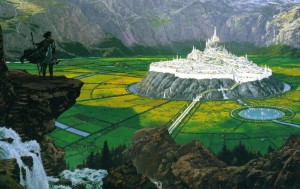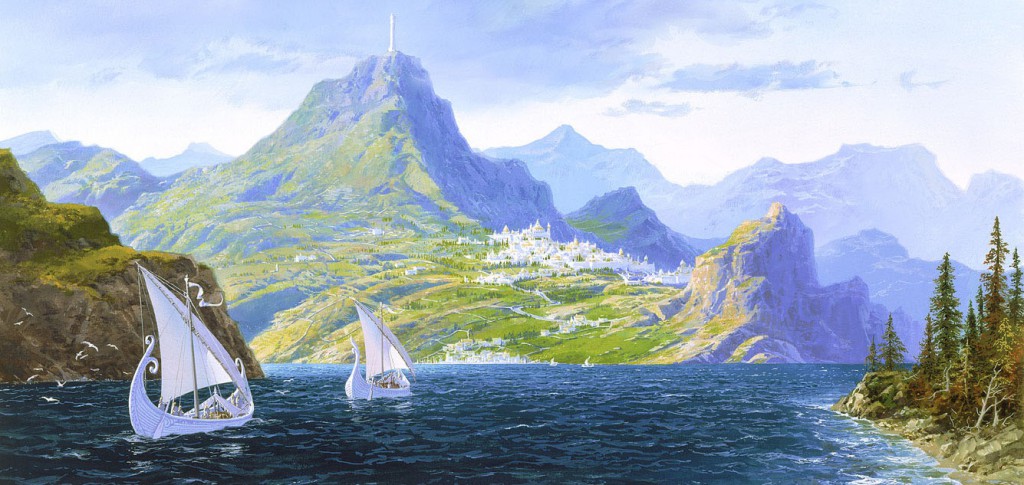 It’s the film project that many of us fear we may never see. Yet surely, with time, all may be possible. In this article, Rud the Spud takes a look at how a trilogy based on Professor Tolkien’s The Silmarillion might be constructed – should such a project ever come to fruition – and discusses whether or not it could possibily live up to the Professor’s massive collection of stories.
It’s the film project that many of us fear we may never see. Yet surely, with time, all may be possible. In this article, Rud the Spud takes a look at how a trilogy based on Professor Tolkien’s The Silmarillion might be constructed – should such a project ever come to fruition – and discusses whether or not it could possibily live up to the Professor’s massive collection of stories.
The Silmarillion Movie Trilogy
By Rud the Spud
It’s an idea that has been capturing the minds of Ringers since the days of Peter Jackson’s The Lord of the Rings movie trilogy and probably before that too; will Peter Jackson or indeed anyone make a movie of The Silmarillion? After the success of The Lord of the Rings in the cinemas, the natural question was “When will he make The Hobbit?” Ten years, eleven Oscars and a few greenlight hitches later, we have just been treated to the second film in a trilogy of Hobbit movies. Old fans are loving the opportunity to delve back into the world of Middle-Earth again, new fans are discovering it for the first time and at the end of it all, naturally (and hopefully), we will still be wanting more. Eyes have already been looking toward The Silmarillion – Tolkien’s posthumously released life’s work telling the story of the First Age of Middle-Earth, the Awakening of the Elves and the events that will ultimately create the world that we know from The Hobbit and The Lord of the Rings.
(SPOILER WARNING FROM HERE ON)
Before we begin, the very quick answer you will get when asking about a Silmarillion movie is that the rights to this book are currently owned by the Tolkien Estate – and judging by their disapproval of the films made to date, they don’t seem to be in a rush to sell them. J.R.R. Tolkien himself sold the film rights of The Hobbit and LOTR back when he believed they were unfilmable and decided to make a quick buck. The Silmarillion, along with The Unfinished Tales and other works by Tolkien which were released after his death, remains in the possession of the Tolkien Estate and because of this, the prospect of a Silmarillion movie happening in the near future is unlikely, as much as we may want it.
This being said, in a scenario that a Silmarillion film – or series of films – were to be made, would they even work as movies? Would they stand the test of the general movie-going audience? How would it translate to the big screen? Could it be translated to the big screen? This article will explore the possibilities and pitfalls of translating The Silmarillion into film by looking at a potential treatment of the films and a brief analysis of the text itself.
The Lord of the Rings was claimed for years to be an unfilmable book. It was too long and complicated and it’s scale and fantasy was massive, but at least it boasted an actual central plot. The Silmarillion unfortunately does not have a central narrative. Those who have read The Silmarillion will know that it is written as a history more so than a novel. It has no central character that drives the story throughout. Instead, it follows certain characters through various episodes in the history of the First Age. Characters such as Feanor, Beren and Luthien are set up as central characters but their roles only last within their own contained episodes, while the history continues. So how would this work in film? The best example of a suitable story telling mechanic would be that of Sin City and Pulp Fiction; two films made up of various interlinking episodes which don’t always follow a strict chronological pattern. With this idea in mind, I have split The Silmarillion into three movies, attempting to capture the key moments from the book in a way that can hopefully make sense.
Film 1 – The War of the Jewels
 The central plot of Film 1 would be based around Feanor and the creation of the Silmarils. Unfortunately, already so much detail would need to be shortened, cut or simplified. An extensive prologue would depict the creation of the world, the Valar, the awakening of the Elves and life in Valinor. Our antagonist is introduced as Melkor, who becomes Morgoth. He is an interesting character in this book, as he gets more characterization than Sauron gets in The Lord of the Rings. He is, of course, our central villain who convinces Feanor – our inventive, passionate, curious elf protagonist – to create the Silmarils, the jewels that capture the light of the Trees of Valinor – the source of light in this pre-sun and moon world. The first major event would be Morgoth and the giant spider Ungoliant sapping the light and life from the Trees and stealing the Silmarils – thus sparking the War of the Jewels. Feanor vows to follow Morgoth back to Middle-Earth to retrieve them.
The central plot of Film 1 would be based around Feanor and the creation of the Silmarils. Unfortunately, already so much detail would need to be shortened, cut or simplified. An extensive prologue would depict the creation of the world, the Valar, the awakening of the Elves and life in Valinor. Our antagonist is introduced as Melkor, who becomes Morgoth. He is an interesting character in this book, as he gets more characterization than Sauron gets in The Lord of the Rings. He is, of course, our central villain who convinces Feanor – our inventive, passionate, curious elf protagonist – to create the Silmarils, the jewels that capture the light of the Trees of Valinor – the source of light in this pre-sun and moon world. The first major event would be Morgoth and the giant spider Ungoliant sapping the light and life from the Trees and stealing the Silmarils – thus sparking the War of the Jewels. Feanor vows to follow Morgoth back to Middle-Earth to retrieve them.
Feanor seizes the boats from the elves of Alqualonde, committing the act of Kinslaying and cursing his people, the Noldor, by leaving Valinor. Feanor reaches Middle-Earth with his followers and burns the ships.
Feanor’s half-brother Fingolfin follows with his people, but must cross the Grinding Ice in the North.
Morgoth would raise his army from his fortress Angband to meet Feanor, and thus the Battle Under the Stars would be fought and Feanor would ultimately have his fight to the death with Gothmog, the Lord of Balrogs. Gothmog will be a recurring character throughout the three movies. Feanor’s death would set a dark and tragic tone to the end of this movie leaving the remaining Noldor caught in a stubborn war against Morgoth.
Verdict – Condensing the content is one thing but writing the dialogue will be very tricky as there are very few passages in the book. It will require skilled writing to create dialogue that allows fans to feel that it is still the words or feel of Tolkien. The style and pace varies as the story progresses and a lot of detail would probably need to be skimmed to have a core film, and audience reaction would be interesting to see with the much darker tone.
Film 2 – Beren and Lúthien
 This film, unlike LOTR and The Hobbit, wouldn’t pick up straight from where the previous film ended. An interesting feature of the narrative in this book is that the main characters are elves and thus the story spans centuries and not mere months. A prologue would allow the audience to catch up on the settlement of the Noldor, the kingdoms of Nargothrond, Gondolin, Doriath, etc. The Battle of Sudden Flame and the duel between Fingolfin and Morgoth would act as an exciting opening similar to The Battle of the Last Alliance and the Balrog fight in LOTR. This would also establish Angband for this movie as well as giving a backstory to the Ring of Barahir from Finrod Felagund. The Awakening of Men would also need to be established.
This film, unlike LOTR and The Hobbit, wouldn’t pick up straight from where the previous film ended. An interesting feature of the narrative in this book is that the main characters are elves and thus the story spans centuries and not mere months. A prologue would allow the audience to catch up on the settlement of the Noldor, the kingdoms of Nargothrond, Gondolin, Doriath, etc. The Battle of Sudden Flame and the duel between Fingolfin and Morgoth would act as an exciting opening similar to The Battle of the Last Alliance and the Balrog fight in LOTR. This would also establish Angband for this movie as well as giving a backstory to the Ring of Barahir from Finrod Felagund. The Awakening of Men would also need to be established.
The story of Beren and Luthien would be the core plot of Film 2.
We would be introduced to Beren retrieving his father’s ring from a band of orcs. He would wander his way into the forest of Doriath to discover the elfmaiden Luthien. He asks for her hand from her father Thingol, the king of Doriath. He demands Beren return with a Silmaril in his hand. The Silmarils Morgoth had placed in his iron crown. We follow the adventures of Beren, Luthien and the hound Huan to Angband, where they retrieve a Silmaril from a sleeping Morgoth and encounter the great wolf Carcharoth. Beren tries to fend him off with his newly stolen Silmaril, but the giant wolf, of course, logically bites his hand off, fleeing in pain in a violent rampage as the Silmaril burns in his gut. Beren and Luthien return to Thingol explaining that technically the Silmaril is in Beren’s hand, although not attached.
The climax would be the hunting of Carcharoth, in the woods of Doriath. Huan and Carcharoth will have a violent fight to the death, ultimately resulting in the death of Beren. In the book, Luthien dies and charms Mandos (basically the Valar of death) to give Beren a second life. This would be a tricky enough concept to pull off right at the end of this movie, but then again if Disney’s Hercules pulled off something similar, it could be done! And thus we would have a lovely happy ending to this second film.
Verdict – This is probably the easiest of the three films to adapt for film. It has a pair of central characters (romantically involved no less), the plot is fun, classic adventure that feels very familiar, but fresh to the audience. Just like Tolkien, this would probably be people’s favourite story!
Film 3 – The End of an Age
 If Film 2 was the easiest to adapt, Film 3 is the most difficult to put together as it would be the most disjointed and possibly would even need a fourth film. It contains so many important events, but with very little solid relationship to each other. In the adaptation process these links could be made artificially, but I’m not going to make them here. It is here that we would employ the Sin City/Pulp Fiction chronology-jumping storytelling style.
If Film 2 was the easiest to adapt, Film 3 is the most difficult to put together as it would be the most disjointed and possibly would even need a fourth film. It contains so many important events, but with very little solid relationship to each other. In the adaptation process these links could be made artificially, but I’m not going to make them here. It is here that we would employ the Sin City/Pulp Fiction chronology-jumping storytelling style.
This film would open with The Battle of Unnumbered Tears, setting up Glaurung the Dragon, the capture of Hurin and the secret kingdom on Gondolin.
We would first have the episode of Turin Turambar, the tragedy of the mighty warrior who is cursed, deceived by Glaurung the Dragon into marrying his own sister and ultimately throws himself on his own blade after all is revealed.
The Ruin of Doriath and the battle between elves and dwarves could be shown here, but it would require setup.
The release of Hurin, after the death of his children, would lead to the story of the Fall of Gondolin, as well as Tuor and the birth of Earendil the Mariner. Arguably you could skip this scene – but, on the other hand, you could give it its own movie! The significance of the depiction of the Fall of Gondolin is that it was the first thing Tolkien had written about Middle-Earth while recovering from the trenches in World War I. It is so iconic in Tolkien’s work, plus it would be a nice link to see Glamdring, Orcrist and even possibly Sting in action!
The final act is tricky because the hero is someone who was born halfway through the film (and we all know we can’t give this job to Arwen). Beleriand is basically overrun, and Morgoth is tightening his inevitable victory. A final plea to the gods, the Valar, is needed. Earendil, the Mortal Man (and father of Elrond no less), leaves to sail west with the Silmaril that they have, to beg the Valar to intervene. He makes it across the sea to Valinor, where he convinces the Valar to come to Middle-Earth, leading to the War of Wrath – a battle of continental scale, which was so destructive that most of Beleriand is sunk into the sea, resulting in the coastline of Middle-Earth that we now know and love. Cue the 2012 Roland Emmerich “end of the world” imagery and awesome aerial battles between dragons and Earendil’s flying ship. Morgoth is defeated in this conflict.
For aid in the war, Men are gifted long life and the island of Numenor. The Silmarils are ultimately lost out of reach of the world and bring an end to the War of the Jewels and the First Age. Earendil is granted to sail across the stars forever more with the light of the Silmaril.
Final Verdict – It is a tricky story to wrap up, and without making drastic changes and edits, I don’t think it could be done justice. Tolkien fans would cry for the discrepancies, and the general movie going audience could be put off with the much darker and tragic tone of the films. The stories more often than not end with your protagonist dying, or the city you’ve grown to love being razed to the ground. Some stories, such as Turin Turambar, I wouldn’t even say are particularly child-friendly, with themes of incest. The Fall of Numenor is yet another story that could get its own movie, but again I find it hard to imagine a general audience buying a tragic, dark ending where most people die with very little hope in the end. I suppose that says a lot for where we are with cinema at the moment, always wanting the happy or at least hopeful endings.
The scale of these films would require ridiculous budgets, which I’m not quite sure studios would regain in the long-term. I would hate to see Tolkien movies increasingly fail at box offices and begin to mar the glory and success that was LOTR. Could these stories work better in a TV series like Game of Thrones? Only with a lot of invention and character building that simply isn’t there in the text, resulting in purist hatred. It really does seem to me that The Silmarillion, realistically, is unfilmable. As amazing as it would be to see these stories realised, I think these are stories best left to the imagination!



